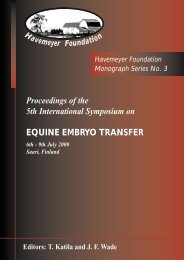Proceedings of a Workshop on - The Havemeyer Foundation
Proceedings of a Workshop on - The Havemeyer Foundation
Proceedings of a Workshop on - The Havemeyer Foundation
You also want an ePaper? Increase the reach of your titles
YUMPU automatically turns print PDFs into web optimized ePapers that Google loves.
<strong>Havemeyer</strong> Foundati<strong>on</strong> M<strong>on</strong>ograph Series No. 11<br />
All horses showing Grade 5 were later<br />
c<strong>on</strong>firmed to show severe obstructive dyspnoea<br />
and that most <str<strong>on</strong>g>of</str<strong>on</strong>g> the Grade 4 horses were also<br />
clinically diseased. This is in line with previous<br />
findings (Morris and Seeherman 1991) which<br />
showed that dynamic collapse <str<strong>on</strong>g>of</str<strong>on</strong>g> the left arytenoid<br />
cartilage (ACC) and vocal fold (VCC) developed<br />
in the overwhelming majority – 20 out <str<strong>on</strong>g>of</str<strong>on</strong>g> 27<br />
horses with Grade 4 (sic) motility at rest. <strong>The</strong><br />
prevalence <str<strong>on</strong>g>of</str<strong>on</strong>g> clinically significant recurrent<br />
laryngeal neuropathy (RLN), ie Grades 4 and 5,<br />
was found to be 2.26% and this can be regarded as<br />
a base level for an unselected populati<strong>on</strong> <str<strong>on</strong>g>of</str<strong>on</strong>g><br />
Thoroughbred horses. It compares with previous<br />
reports <str<strong>on</strong>g>of</str<strong>on</strong>g> selected groups (Table 1).<br />
<strong>The</strong> greatest diversity <str<strong>on</strong>g>of</str<strong>on</strong>g> opini<strong>on</strong> hinges <strong>on</strong> the<br />
significance <str<strong>on</strong>g>of</str<strong>on</strong>g> Grade 3 motility and whether this<br />
represents a performance-limiting malfuncti<strong>on</strong>, or<br />
whether it should be viewed as a variant <str<strong>on</strong>g>of</str<strong>on</strong>g><br />
normality. This grading does not discriminate<br />
between the abilities to achieve and to maintain<br />
full abducti<strong>on</strong> as these are subjective judgements.<br />
A large number <str<strong>on</strong>g>of</str<strong>on</strong>g> group, listed and stakes race<br />
winners have come from the horses with this<br />
grading. <strong>The</strong> numbers <str<strong>on</strong>g>of</str<strong>on</strong>g> Grade 3 horses which<br />
required, or were subjected to corrective surgery<br />
later in life, is not known but from studies <str<strong>on</strong>g>of</str<strong>on</strong>g><br />
animals examined by highspeed treadmill<br />
endoscopy (see page 47) it is safe to c<strong>on</strong>clude that<br />
the majority are ‘normal’, showing sustained<br />
symmetrical abducti<strong>on</strong> <str<strong>on</strong>g>of</str<strong>on</strong>g> the arytenoid cartilages<br />
and vocal folds throughout exercise. However,<br />
horses with Grade 3 RLN are at a significantly<br />
greater risk <str<strong>on</strong>g>of</str<strong>on</strong>g> sustaining ACC and/or VCC at<br />
exercise than horses with Grades 1 and 2 RLN.<br />
Although the designati<strong>on</strong> <str<strong>on</strong>g>of</str<strong>on</strong>g> a Grade 1 or 2<br />
score during quiet breathing does not c<strong>on</strong>vey<br />
absolute protecti<strong>on</strong> against ACC or VCC during<br />
exercise, susceptible horses invariably show other<br />
features such as palpable atrophy <str<strong>on</strong>g>of</str<strong>on</strong>g> the cricoarytenoideus<br />
dorsalis muscle and a progressive<br />
inspiratory noise at exercise.<br />
In c<strong>on</strong>clusi<strong>on</strong>, the 5-point grading scheme for<br />
RLN has proved to be a practicable means to<br />
assess laryngeal functi<strong>on</strong> in Thoroughbreds that<br />
has a useful predictive value with regard to the<br />
likelihood <str<strong>on</strong>g>of</str<strong>on</strong>g> clinical disease, provided it is used<br />
in c<strong>on</strong>juncti<strong>on</strong> with such techniques as palpati<strong>on</strong><br />
and an exercise test. Assessments <str<strong>on</strong>g>of</str<strong>on</strong>g> upper<br />
respiratory tract functi<strong>on</strong> that rely <strong>on</strong> endoscopy<br />
during quiet breathing al<strong>on</strong>e should be regarded<br />
TABLE 2: Previous endoscopic surveys to<br />
assess laryngeal functi<strong>on</strong> in horses<br />
Authors Group Populati<strong>on</strong> RLN<br />
size<br />
incidence<br />
(sic. grades<br />
4 and 5)<br />
Pascoe et al. 235 Horses in 2.6%<br />
(1981) training<br />
Raphael 479 " 3.3%<br />
(1982)<br />
Baker 537 " 4.7%<br />
(1983)<br />
Lane et al. 6860 Yearlings at 0.96%<br />
(1987) sale<br />
Sweeney et al. 678 Horses in 4.0%<br />
(1991) training<br />
as inadequate.<br />
REFERENCES<br />
Baker, G.J. (1983) Laryngeal asynchr<strong>on</strong>y in the horse:<br />
definiti<strong>on</strong> and significance. In: Equine Exercise<br />
Physiology, Eds: D.H. Snow, S.G.B. Perss<strong>on</strong> and<br />
R.J. Rose. Granta Editi<strong>on</strong>s, Cambridge, 46-50.<br />
Kannegeiter, N.J. and Dore, M.L. (1995) Endoscopy <str<strong>on</strong>g>of</str<strong>on</strong>g><br />
the upper respiratory tract during treadmill exercise:<br />
a clinical study <str<strong>on</strong>g>of</str<strong>on</strong>g> 100 horses. Aust. vet. J. 72, 101-<br />
107.<br />
Lane, J.G., Ellis, D.E. and Greet, T.R.C. (1987)<br />
Observati<strong>on</strong>s <strong>on</strong> the examinati<strong>on</strong> <str<strong>on</strong>g>of</str<strong>on</strong>g> Thoroughbred<br />
yearlings for idiopathic laryngeal hemiplegia.<br />
Equine vet. J. 19, 531-536.<br />
Lane, J.G. (1993) Equine recurrent laryngeal neuropathy<br />
(RLN): current attitudes to aetiology, diagnosis and<br />
treatment. <str<strong>on</strong>g>Proceedings</str<strong>on</strong>g> <str<strong>on</strong>g>of</str<strong>on</strong>g> the 15th Bain-Fall<strong>on</strong><br />
Memorial Lectures, Aust. equine vet. Ass. 173-192.<br />
Morris, E.A. and Seeherman, H.J. (1991) Clinical<br />
evaluati<strong>on</strong> <str<strong>on</strong>g>of</str<strong>on</strong>g> poor performance in the racehorse: the<br />
results <str<strong>on</strong>g>of</str<strong>on</strong>g> 275 evaluati<strong>on</strong>s. Equine vet. J. 23, 169-174.<br />
Pascoe, J.R., Ferraro, G.L., Cann<strong>on</strong>, J.H., Arthur, R.M.<br />
and Wheat, J.D. (1981) Exercise-induced<br />
pulm<strong>on</strong>ary haemorrhage in racing Thoroughbreds: a<br />
preliminary survey. Am. J. vet Res. 42, 703-707.<br />
Rakestraw, P.C., Hackett, R.P., Ducharme, N.G., Nielen,<br />
G.J. and Erb, H.N. (1991) Arytenoid cartilage<br />
movement in resting and exercising horses. Vet.<br />
Surgery 20, 122-127.<br />
Raphael, C.F. (1982) Endoscopic findings in the upper<br />
respiratory tract <str<strong>on</strong>g>of</str<strong>on</strong>g> 479 horses. J. Am. vet. med. Ass.<br />
181, 470-473.<br />
Sweeney, C.R., Maxs<strong>on</strong>, A.D. and Soma, L.R. (1991)<br />
Endoscopic findings in the upper respiratory tract <str<strong>on</strong>g>of</str<strong>on</strong>g><br />
678 Thoroughbred racehorses. J. Am. vet med. Ass.<br />
198, 1037-1038.<br />
25








